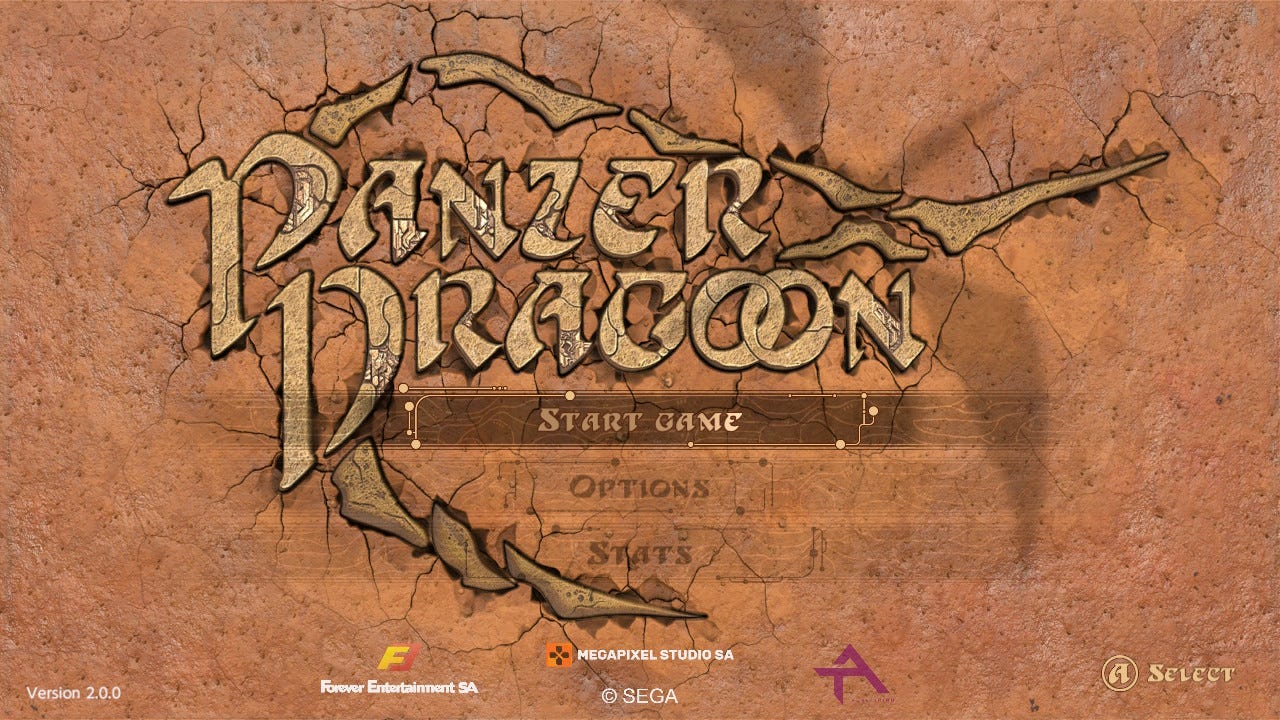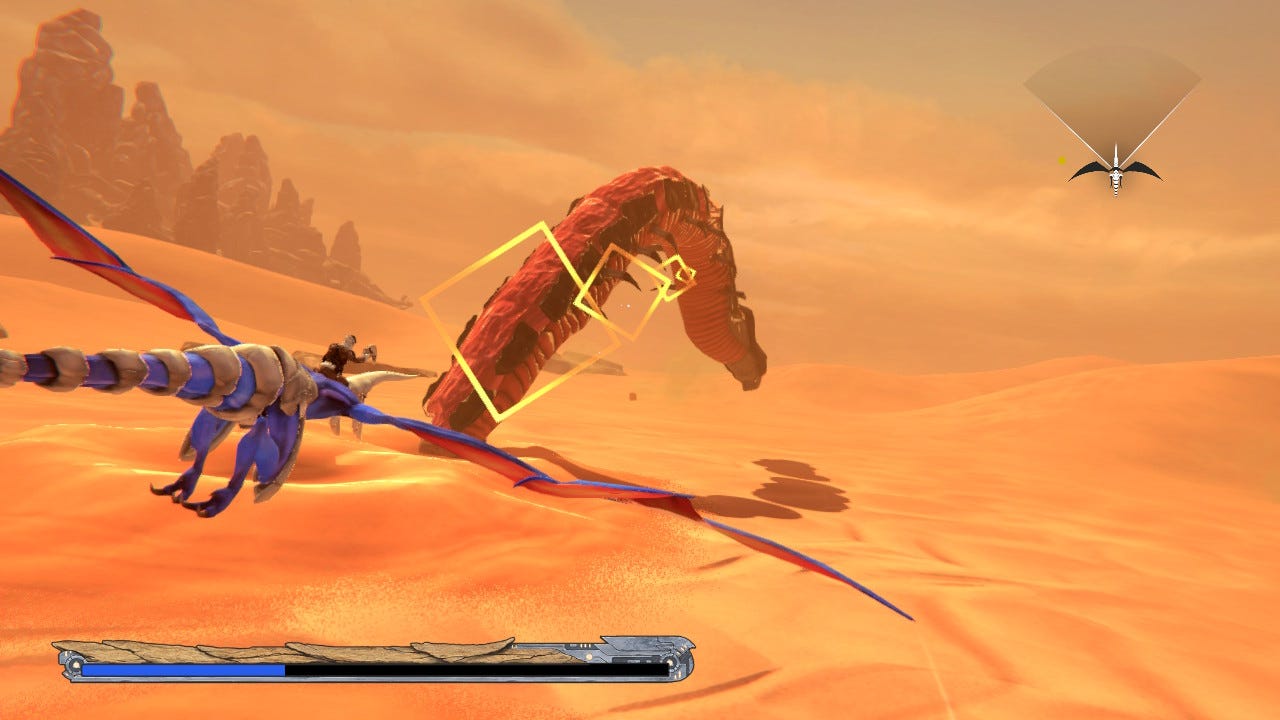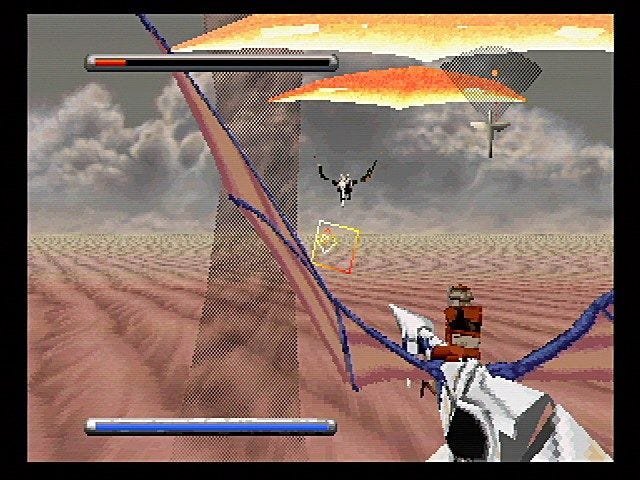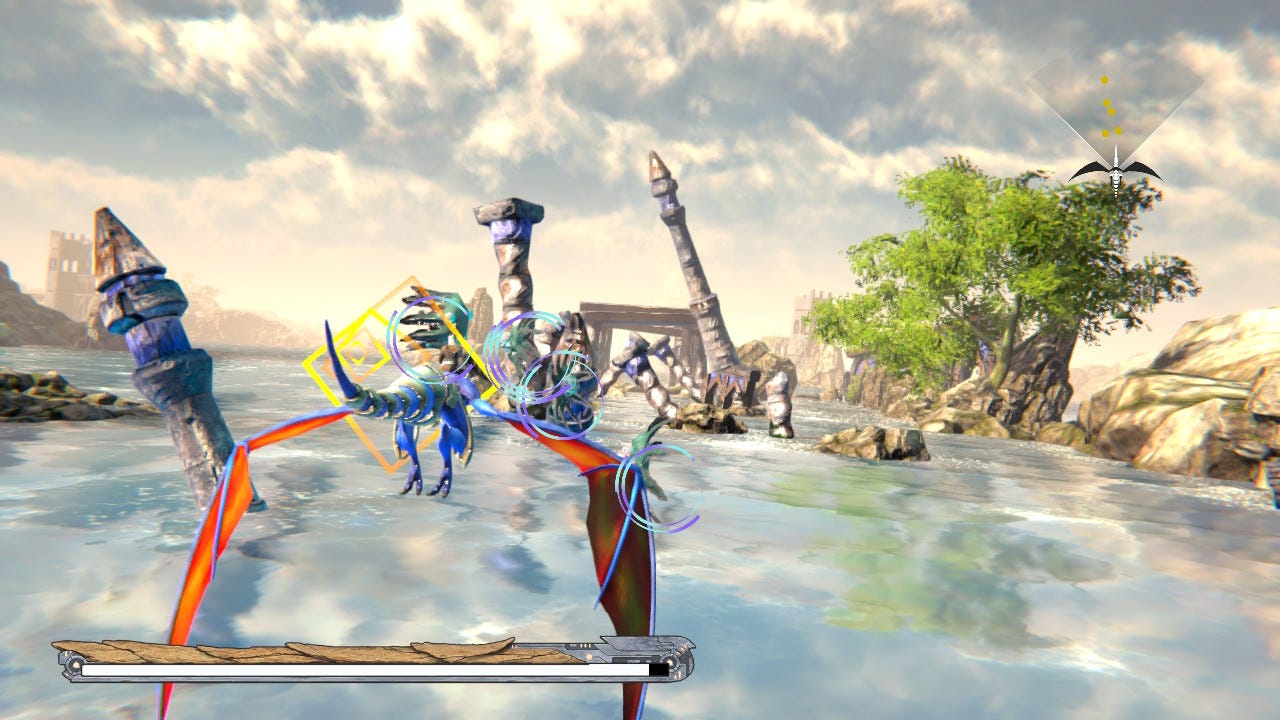Past meets present: Panzer Dragoon
A key title for the Sega Saturn received a wide-release HD remake 25 years after its initial release.
This column is “Past meets present,” the aim of which is to look back at game franchises and games that are in the news and topical again thanks to a sequel, a remaster, a re-release, and so on. Previous entries in this series can be found through this link.
To understand why Panzer Dragoon was made the way it was, you have to understand what was going on at Sega at the time. The company had just spent years trying to defeat Nintendo in what were dubbed “the console wars,” and while they failed miserably at the task in Japan, at least in regions like North America, Europe, and in the extremely pro-Sega Brazil, things were going much better: Nintendo’s leading sales of the Super Famicom in Japan are the only reason the worldwide race was at close as it was. The Sega Saturn was meant to be the next step, a 32-bit leap into the future, but there was a problem. While Nintendo wasn’t quite ready to leave the 16-bit era behind in 1994, potentially giving Sega the same kind of head start they received with the Genesis, a new challenger was emerging: the Sony Playstation was on the way.
Attention shifted from Nintendo, whose 64-bit SNES successor was still a ways off, to Sony. Yukio Futatsugi, the director of Panzer Dragoon, designed the game in no small part around the idea of what the Saturn could do that the Playstation could not. The Saturn could handle 3D, but it didn’t do so in the same fashion as the Playstation. The Saturn was the better system for 2D graphics — as anyone who has actually spent some time with a Saturn can vouch for — but the Playstation had the superior 3D tech because of the way the system handled the process: getting quality 2D graphics onto the Playstation is what would take quite a bit of work, as that simply wasn’t the focus for Sony or its engineers and developers.
Futatsugi, speaking with Kotaku in 2019, explained that the “infinite plane” was Panzer Dragoon’s ticket to doing something with 3D that the Playstation could not — a way to make it seem as if the Saturn’s 3D capabilities weren’t as limited as they actually were, that the system was capable of keeping pace in this regard.

As Chris Kohler wrote in that same piece:
The Saturn had a special graphics chip that could draw massive 3D planes with textures all the way to the end of the horizon. If the PlayStation wanted to do this, it would have to spend a lot of its limited amount of onscreen polygons to do what the Saturn could do for “free,” and even then, it likely couldn’t draw the planes all the way to the horizon.
So the Panzer Dragoon team, named Team Andromeda, structured the look of the game’s world around the idea of the infinite plane, with lots of wide-open space—vast oceans, blue skies, endless deserts. The game was designed as something truly native to the Sega Saturn hardware, showing off its unique strengths and downplaying its weaknesses.
This issue with horizons persisted throughout the Playstation’s lifespan — the differences in how a game like Space Station Silicon Valley looked on the Nintendo 64 compared to the Playstation had a lot to do with how the Playstation (poorly) handled objects on the horizon in comparison to the N64’s exceptional draw distance — so, Futatsugi picking up on that advantage before either system really even got going is impressive work. And Panzer Dragoon was truly built around this “infinite plane,” as so much of the game is just backgrounds that, for the time, seemed impossible. And you just get to fly by them, through them, whatever: there’s a reason that Panzer Dragoon: Remake, first released in 2020, includes both a photo mode and the option to turn off the HUD.
Looking back from today’s world of ray tracing and promises of eventual 8K resolution for the Playstation 5, without the proper context, what Panzer Dragoon did at the time doesn’t necessarily seem all that impressive. Knowing that this was at the advent of true, dedicated 3D consoles, though, just a few years after titles like Namco’s Starblade and Nintendo’s Star Fox arrived and changed what was possible for on-rails shooters through the use of extremely blocky polygons and wireframe 3D models? Just 14 months after DOOM took the world by storm with its 2D sprites in a 2D space that was shown from a first-person perspective to give the illusion of true 3D? Panzer Dragoon was a revelation. You were on-rails, yes, but you could move around in this 3D space, and see these textured polygons well off into the distance, dodging and weaving by your enemies and the shots they fired at you not from a first-person perspective like in Starblade, not with a visible weapon in hand like in DOOM, but with the Saturn rendering a complete third-person dragon that you could see, and change the perspective of at will. And not in an extremely blocky polygonal way like in Star Fox did with its Arwings, either. These were textured 3D models!
The Saturn’s tech allowed for these things to happen, but it took quality art design and execution for that to matter. While influence might have come from Starblade and other existing on-rails shooters for the gameplay itself, the environments that all of this would play out in were going to be much different. Fantastical, fantasy-based worlds were the goal here, as these space games were too “sterile” for Panzer Dragoon’s lofty goals. Beautiful bodies of water covering up drowned cities, vast deserts full of enormous sandworms, mountains and canyons, detailed interior spaces be they caves or man-made tunnels, cities with buildings and bridges and waterways to fly in and around: Panzer Dragoon switched up its locations every episode, in order to paint brand new pictures for you to stare at while you defended yourself from atop a dragon. French artist Jean Giraud, who used the pseudonym Mœbius, was both an influence and contributor to the game’s art. As Hardcore Gaming 101’s Kurt Kalata pointed out in their own look at the game, Nausicaä of the Valley of the Wind and David Lynch’s vision of Dune were visual influences, as well (and the Nausicaä bits likely go well beyond just visual inspiration, which itself was inspired in no small part by Mœbius’ work).
And the game had a couple of FMV cinematics, with the lengthy (and I mean lengthy) opening one showing just how the protagonist, Keil, came to be atop the blue dragon, and a later one preceding the creation of the final boss in front of your eyes. This was meant to be a visual showcase, one that could show off what the Saturn could do so that people would then go out and buy one. And while it of course all looked worse in 1998, by the end of the Saturn’s lifespan and the release of the final Panzer Dragoon title on the system, there was nothing like it back in ‘95.
The Panzer Dragoon team was influenced by Starblade, as Futatsugi told Kotaku that its “cinematic presentation” and “Star Wars-like story” guided Panzer Dragoon’s own emphasis on cinematics, character, and a story that went beyond what was always seen in shooters of the day. Starblade released in arcades in 1991, then the Sega CD and 3DO for its early home conversions, and finally on the Playstation as Starblade Alpha in 1995 and 1996. The game inspired not just Panzer Dragoon, but Star Fox and Rez, as well, and it’s pretty clear that the direction of Star Wars arcade games gave at least a nod to Starblade after its release. It was a big deal, even if it maybe didn’t seem like it to console-only gamers, as it was a huge hit in arcades and directly influenced plenty of future titles from other studios.
One thing all three of these games (and plenty of other rail shooters, flying or otherwise) have in common is an attempt to put more on-screen at once than you can reasonably deal with. You have to pick and choose — or be very well prepared and skillful, too — to take everything down and avoid damage. More realistically, you’re going to miss some enemies and some of their projectiles, and it’s going to hurt you. Panzer Dragoon was at one time considered almost unreasonably difficult, as it expected you to complete levels in a single attempt without checkpoints, and your credits, on normal and hard modes, were based largely on how many more continues you could earn through accurately shooting down the vast, vast majority of foes in a stage. On easy, you had infinite credits, and at least on normal you started with a few to get you going there, but on hard? You have to earn every continue you have. The difficulty was enough that Team Andromeda, the developer, ended up changing how things would work with the second game, making the difficulty variable based on how well you were doing actually shooting down foes, as well as how regularly you were dying.
With that being said, Panzer Dragoon feels pretty easy in the present, but maybe that’s just decades of familiarity with the genre speaking: decades that didn’t necessarily exist back when Panzer Dragoon first arrived on the scene, given both Starblade and Star Fox had released just a few years prior, also in the 90s. In fact, while it was vastly visually superior to Star Fox and Starblade when it came out in ‘95, you could make a pretty reasonable argument that those two games have actually aged better when it comes to the gameplay. Panzer Dragoon was as important as those two in establishing new paradigms of 3D gaming for the genre, but it leaned a little more heavily on its look than the other two: it feels a little empty, in comparison, its obstacles easier to overcome, especially once you become even a little bit familiar with its systems. Both Star Fox and Starblade don’t let you take nearly as much of a beating, load their screens up with plenty of enemies themselves, and can be just as unforgiving about continuing on after death.

That’s not to say that Panzer Dragoon is bad in 2023 just because years have gone by — it’s still a good game! — or that it’s not worth it to experience its remake whether you’re familiar with or new to Sega’s on-rails shooter from its Saturn days. It’s just pretty clear to see why later Panzer Dragoon titles expanded on the gameplay: there was plenty of room to do so, and the initial wow factor of Panzer Dragoon’s graphics and cinematics would only last for so long. Panzer Dragoon might feel like a bit of a letdown, either because your memories of it suggested something greater, or you’ve heard so much more about it than what you’ll get. The good news, though, is that a remake of its first sequel, Zwei, is expected to eventually release, and Panzer Dragoon Orta, an Xbox exclusive, is backwards-compatible and available digitally on modern Xbox systems. There are superior Panzer Dragoon titles out there, is the thing, and the first one is still enjoyable all this time later.
As for how Panzer Dragoon plays, it’s fairly basic. It’s an on-rails shooter, and you have two ways to attack: press the fire button to shoot from Keil’s handgun, or hold it down to start targeting enemies for homing blasts fired from the blue dragon. The homing blasts are powerful but take time to charge up, so you’ll have to be constantly debating whether it’s better for you to mash the fire button to rapid-fire Keil’s shots to down a foe, or if you want to target and fire slowly with the more powerful dragon blasts. You aren’t just firing at what’s in front of you, but, using the shoulder buttons, rotate the camera so you can see to the sides of you as well as behind. A radar is in the top right of the screen, and the radar’s orientation is unchanging: if yellow or red dots are moving from the top of the radar toward the dragon, they’re coming from in front of you. If they’re behind the dragon, the foes are behind you, and to the sides… you get the picture. All of this is true whether you’re looking forward or not, so you might slip up sometimes and think “hey that’s behind me,” but once you recall how the radar’s orientation is fixed, you’ll get used to hitting the buttons as you need to.
You’ll have to defeat loads of enemies, of the one-shot popcorn variety as well as ones that take a real pounding to the point where you wonder if you’re actually able to defeat them at all. Some bosses can be a bit annoying as you learn this: they might take damage at one point, but not during others, usually as they’re preparing whatever the next segment of the battle is. That you can still target them with the dragon’s homing shots even when those shots won’t damage them is where some of the confusion comes from, but again, you’ll be able to work out these moments with exposure to them.
In addition to the enemies themselves, you’re also able to destroy many of the rounds they fire at you. Torpedoes, missiles, globs of poison liquids, whatever. It’s destructible, so you can attempt to dodge it and get hit by something else being fired at you, or give destroying all of it, including the source of the shots, a go. Speaking of dodging, your dragon will point wherever your reticule does, which does take some getting used to, since you can’t both move and aim independently of each other. The Saturn’s controller just had a D-pad, after all, and the shoulder buttons were being used to rotate the camera. Panzer Dragoon: Remake does include a modern dual-stick setup, which will take getting used to in the other direction if you’re familiar with the original Panzer Dragoon controls where moving and aiming were tied together into one action, but it does as good of a job of modernizing the game as any of the visual upgrades managed, and allows you to both dodge and fire at something that isn’t directly in front of the dragon’s snout at the same time.
That reticule, regardless of whether classic or modern controls are selected, isn’t a flat object. It’s meant to measure trajectory: the smallest rotating square is where your shot will actually head, while the rest of the larger squares point the path of the shot out. So you’ll miss if you’re leading with the portions of the reticule closer to where the shots are fired from. It makes a lot of sense when you see it in action, but since it’s a series of reticules piled on top of each other, it can work a little differently than expected if you treat it like a standard one.
One issue Panzer Dragoon was always plagued with was slowdown: it was common for the times, so it wasn’t considered a dealbreaker back in 1995, but when the remake landed and still included slowdown, well, that impacted both critic and user scores and views on the game. MegaPixel Studio, the developer of Panzer Dragoon Remake, ended up patching in fixes for the controls and a Performance Mode that knocks down the graphical fidelity of the remake a bit, but in exchange, has the whole thing running at a rock solid 60 frames per second. So, like with many shooters past and present, you can determine which part of the performance you want to be compromised based on your own preferences. (And it should be noted that, at this point, too, the gap between the game’s performance in or out of performance mode has lessened in comparison to where it was before.) Panzer Dragoon isn’t a bullet hell experience where I feel I can use the slowdown to my advantage, so Performance Mode felt worth it to me to keep things stable, but if you wanted to mess with photo mode or just check out the various vistas and scenery with the invulnerable God Mode enabled, well, crank those graphics up.
The remake includes both a new version version of the game’s soundtrack, arranged by Saori Kobayashi, as well as the original composed by Yoshitaka Azuma. It’s an exceptional soundtrack, with some real standout compositions — “Flight,” included above, does a tremendous job of making sure the game’s sound was doing its part in making you feel like you were on top of a dragon, riding the wind.
While Panzer Dragoon: Remake did have its initial problems in its 1.0 form, it’s also, at this point, far and away the definitive way to experience the game. The original Saturn edition is available inside of Panzer Dragoon Orta as an extra on the Xbox Series X|S and One consoles, but other than that? It’s no longer on Windows, as it was in the 90s, and the Playstation 2 Sega Ages edition both never left Japan and is lacking in the kind of upgrades that were present elsewhere in that line of games. You can buy a Saturn version of the game if you do have a Saturn, of course, but that’s a choice that only looks inexpensive when compared to how much the other Saturn sequels, Zwei or Panzer Dragoon Saga, go for on the secondary market.
No, the remake is the way to go at this point, not just because of its various upgrades and enhancements, but also because it’s available everywhere, and for not all that much money. The publisher, Forever Entertainment, has regularly and significantly discounted the game, maybe as a way of attempting to counter the initial backlash: if it’s available cheap, maybe it’s worth checking out despite the feedback at release, you know? And it is worth checking out, because it’s certainly been fixed now, and in such a way that gives promise to the eventual quality of Panzer Dragoon II Zwei: Remake.
This newsletter is free for anyone to read, but if you’d like to support my ability to continue writing, you can become a Patreon supporter, or donate to my Ko-fi to fund future game coverage at Retro XP.






I also remember loving Orta on the OG Xbox. Really enjoyed the look/vibe of these games